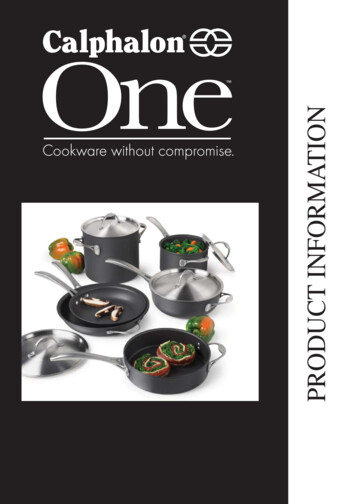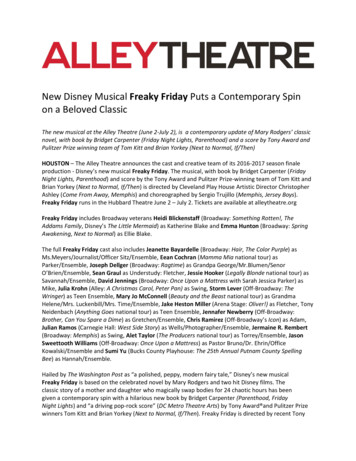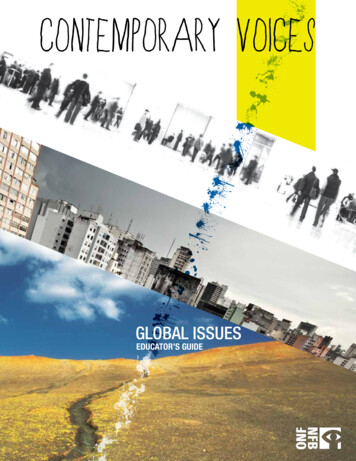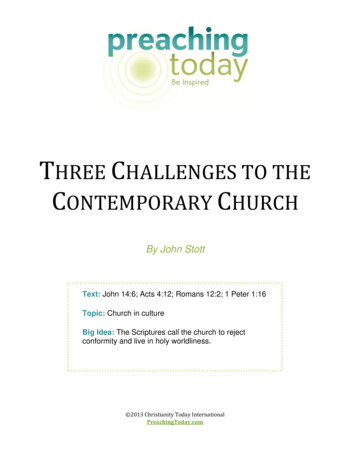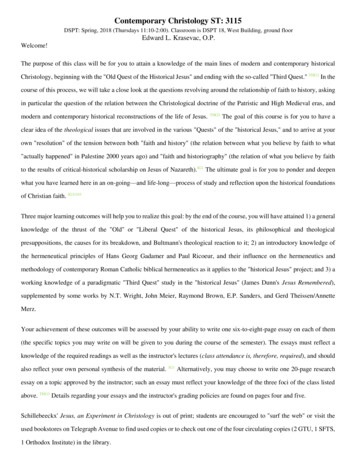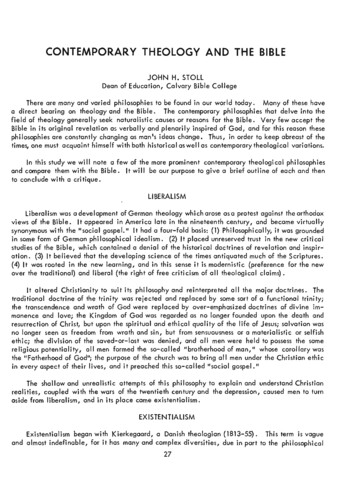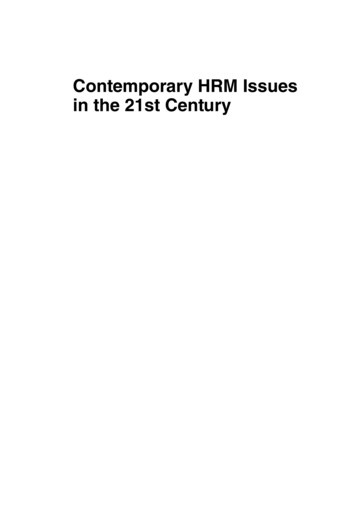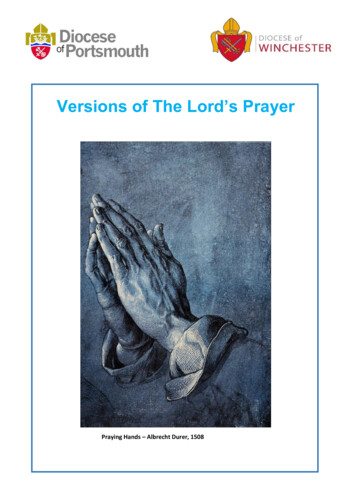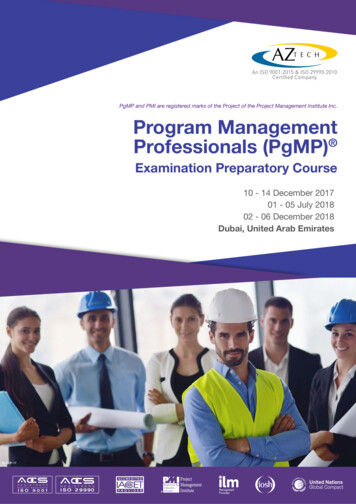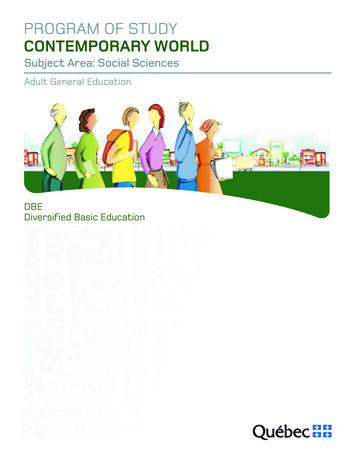
Transcription
PROGRAM OF STUDYCONTEMPORARY WORLDSubject Area: Social SciencesAdult General EducationDBEDiversified Basic Education
PROGRAM OF STUDYCONTEMPORARY WORLDSubject Area: Social SciencesAdult General EducationDBEDiversified Basic Education
This document has been adapted from the Contemporary World section of the Québec Education Program, Secondary CycleTwo.Coordination and contentDirection de l’éducation des adultes et de l’action communautaireSecteur du développement pédagogique et du soutien aux élèvesEnglish translationDirection des services à la communauté anglophone – Services langagiersTitle of original document: PROGRAMME D’ÉTUDES, Monde contemporain, Formation générale des adultesFor additional information, contact:Direction de l’éducation des adultes et de l’action communautaireMinistère de l’Éducation, de l’Enseignement supérieur et de la Recherche1035, rue De La Chevrotière, 13e étageQuébec (Québec) G1R 5A5Telephone: 418-643-9754An electronic version of this document is available on the Web site of the Ministère de l’Éducation, de l’Enseignement supérieuret de la Recherche at: www.meesr.gouv.qc.ca. Gouvernement du QuébecMinistère de l’Éducation, de l’Enseignement supérieur et de la Recherche, 2015ISBN 978-2-550-72486-5 (PDF)ISBN 978-2-550-72485-8 (French edition)Legal deposit – Bibliothèque et Archives nationales du Québec, 201514-00496
Table of ContentsChapter 1 Introduction . 11.1Contribution of the Program to the Education of Adult Learners . 31.2Nature of the Program . 31.3Connections Between the Program and the Other Elements of the Diversified Basic EducationProgram . 41.3.1 Connections With the Broad Areas of Learning . 41.3.2 Connections With the Cross-Curricular Competencies . 61.3.3 Connections With the Other Subject Areas . 8Chapter 2 Pedagogical Context . 112.1Learning Situations . 132.2Families of Learning Situations . 142.3Educational Resources. 14Chapter 3 Subject-Specific Competencies . 153.1How the Subject-Specific Competencies Work Together . 173.2Competency 1 Interprets a contemporary world problem . 183.2.1 Focus of the Competency . 183.2.2 Key Features and Manifestations of the Competency . 193.2.3 Development of the Competency. 203.3Competency 2 Takes a position on a contemporary world issue . 213.3.1 Focus of the Competency . 213.3.2 Key Features and Manifestations of the Competency . 223.3.3 Development of the Competency. 223.4The Research Process . 23Chapter 4 Subject-Specific Content. 254.1Knowledge . 274.1.1 Designated Focus . 294.1.2 Objects of Learning . 294.1.3 Concepts . 294.1.4 Theme-Related Knowledge . 294.2Cultural References . 294.3Techniques . 30Chapter 5 Organization of the Courses in the Program . 31Chapter 6 Courses . 35SST-5101-2 Contemporary World Problems and Issues I . 39A.Knowledge . 43
B.C.Cultural References . 51Techniques . 52SST-5102-2 Contemporary World Problems and Issues II . 55A.Knowledge. 59B.Cultural References . 64C.Techniques . 64APPENDIXES . 69Appendix 1 Cross-Curricular Competencies . 71Appendix 2 Techniques . 73Appendix 3 Subject-Specific Competencies, Key Features and Manifestations . 79Appendix 4 The Research Process . 81Bibliography . 83
List of TablesTable 1 Key Features and Manifestations of Competency 1 . 19Table 2 Parameters Related to the Development of Competency 1 . 20Table 3 Key Features and Manifestations of Competency 2 . 22Table 4 Parameters Related to the Development of Competency 2 . 23Table 6 Prescribed Elements of the Course Contemporary World Problems and Issues I . 43Table 7 Prescribed Elements of the Course Contemporary World Problems and Issues II . 59
Chapter 1Introduction
Chapter 1 IntroductionIn today’s constantly changing world, societies are becoming increasingly interdependent and havemore social, economic, political and cultural relationships. Similarly, the problems and issues thatcharacterize the contemporary world are interconnected and multidimensional. As a result, thevarious actors—states, organizations, and citizens—are called upon to work together to find globalsolutions.To study these problems and issues, one must see them from both geographic and historicalperspectives, and consider the economic and political dimensions.1.1Contribution of the Program to the Education of Adult LearnersThe Contemporary World program is part of the Social Sciences. It deals with problems and issuesrelated to the environment, population, wealth, power and tensions and conflicts. Thus, adultlearners become aware of the consequences of human actions on societies, develop criticaljudgment, and define their understanding of the world. As responsible citizens, adults learn toparticipate in social debates and contribute to society.The Contemporary World program allows adult learners to develop the following subject-specificcompetencies: Interprets a contemporary world problem and Takes a position on a contemporaryworld issue, competencies that contribute to adult learners’ general education, prepare them to takepart in society and make up their minds regarding social debates.1.2Nature of the ProgramThe aim of the Contemporary World program is to help adult learners become interested incontemporary world problems and issues that all societies face, develop competencies andconstruct knowledge.By studying these problems and issues, adults learn to understand the nature of the relationshipsthat form between societies and the way in which these relationships shape the organization of theworld today. They become aware of the different viewpoints regarding some of the world’s greatconcerns. They compare their own point of view with that of others, thus increasing their criticaljudgment. They become aware of the role they must play in society and of their responsibilities ascitizens.The subjects involved in the study of the Contemporary World program―geography, history,economics and political science—help adult learners approach contemporary world problems andissues from a geographic and historical perspective while taking into account their economic andpolitical dimensions:Diversified Basic Education Program, Contemporary World3
Chapter 1 IntroductionA geographic perspective helps adult learners consider phenomena in terms of territory, thatis, in terms of the effects of human action on spatial organization.A historical perspective helps adult learners view the same phenomena in terms of durationby seeking the origins of the phenomena and elements of change and continuity related tothem.Taking into account the economic dimension helps adult learners understand the choicessocieties make regarding the organization of trade, production, distribution and consumptionas well as the organization of work.Considering the political dimension helps adult learners understand the organization ofpower within societies and the formation of power relations.Each of these subjects makes a complementary contribution to the understanding of problems andissues facing the contemporary world.1.3Connections Between the Program and the Other Elementsof the Diversified Basic Education ProgramConnections between the Contemporary World program and other subjects are readily apparent.They facilitate the integration of various elements of the Diversified Basic Education Program,namely, the broad areas of learning, the cross-curricular competencies and other subject areas.1.3.1Connections With the Broad Areas of LearningThe broad areas of learning deal with major issues that adults confront, both individually andcollectively, in different areas of their lives. They help motivate and support adults in their learningand guide them in their involvement as citizens. Each broad area of learning raises many questionsthat could become the basis for learning situations. Each one consists of an educational aim andfocuses of development that help give meaning to learning.To varying degrees, the Contemporary World program has connections with all five broad areas oflearning.Citizenship and Community LifeThe Contemporary World program has strong ties to the broad area of learning Citizenship andCommunity Life. Its educational aim is to enable adult learners to take part in democratic life anddevelop an attitude of openness to the world and respect for diversity. This educational aim and itsrelated focuses of development are consistent with one of the aims of the program—that ofpreparing adult learners to participate, as responsible citizens, in social debate.4Diversified Basic Education Program, Contemporary World
Chapter 1 IntroductionBy studying the prescribed themes, adult learners observe the diversity of societies and acquireknowledge about the principles that characterize a democratic society. By taking a position oncontemporary world issues, adult learners discover opportunities for social participation. Theyconsider the role of institutions in society and determine the role that individuals can play in them.They may also observe that, regardless of period or place, human beings form relationships ofvarious sorts and try to find shared solutions to common problems by establishing rules for life insociety.Environmental Awareness and Consumer Rights and ResponsibilitiesThe Contemporary World program is also closely related to the broad area of learning EnvironmentalAwareness and Consumer Rights and Responsibilities, particularly its educational aim, which is toencourage adult learners to develop an active relationship with their environment while maintaining acritical attitude toward consumption and the exploitation of the environment.Some elements of the focuses of development of this broad area of learning, particularlyenvironmental management and the distribution of wealth in the world, overlap with the themesunder study.Media LiteracyThere are also connections between the program and the educational aim of the broad area oflearning Media Literacy, which is to enable adult learners to exercise critical, ethical and aestheticjudgment with respect to the media and to produce media documents that respect individual andcollective rights.In the course of their research on contemporary world problems and issues, adult learners gatherdata from various sources, which may present opposing viewpoints or biased information, andexercise critical judgment in constructing their own opinions on the topics.Career Planning and EntrepreneurshipThe Contemporary World program fosters the integration of adult learners into society and the labourmarket. It thus contributes to the educational aim of the broad area of learning Career Planning andEntrepreneurship, which is to enable adult learners to make and carry out plans designed to developtheir potential and help them integrate into society.The program also shares common ground with the focuses of development of this broad area in thatit helps adult learners realize the importance of their participation and action in society. Adultlearners are thus encouraged to become involved, pursue various projects and put their experienceto good use in social, personal, academic and job-related tasks in order to continue learningthroughout their lives.Diversified Basic Education Program, Contemporary World5
Chapter 1 IntroductionHealth and Well-BeingThe educational aim of the broad area of learning Health and Well-Being is to encourage adultlearners to develop a sense of responsibility for adopting good living habits. In this sense, theContemporary World program gives adult learners the opportunity to consider the consequences ofhuman actions and collective choices for individual well-being.In addition, some elements of the focuses of development of this broad area concern individual andgroup choices.1.3.2Connections With the Cross-Curricular CompetenciesThe Contemporary World program enables adult learners to develop cross-curricular competencies.Like subject-specific competencies, cross-curricular competencies help adult learners act effectivelyby mobilizing a number of resources. However, these competencies provide a broader frame ofreference in that they cut across subject boundaries and allow for a greater range of action.Each of the subject-specific competencies in the program is, to some extent, dependent on theapplication of cross-curricular competencies, which in turn promote the development of subjectspecific competencies. Appendix 1 provides a list of the cross-curricular competencies.Intellectual competenciesUses informationGiven the central role played by documents, adult learners are required to mobilize the competencyUses information when they interpret a problem or take a position on a contemporary world issue.They must search for information systematically, acquire the information and use it, drawingjudiciously on various sources.Solves problemsWhen defining various social issues, adult learners must use problem-solving strategies in order toexplore and test possible solutions, particularly when expressing opinions and looking for actions tosupport these opinions.Exercises critical judgmentAdult learners develop the cross-curricular competency Uses critical judgment when they assess therelevance of documents they consult, taking into account their own frame of reference and that ofauthors of documents. They learn to construct and express their opinions and put them inperspective, taking into account what seems most fair and valid to them.6Diversified Basic Education Program, Contemporary World
Chapter 1 IntroductionUses creativityAdult learners develop the cross-curricular competency Uses creativity by using the resources andmaterials available in an imaginative way. They must absorb the elements of a contemporary worldproblem or issue, explore the situation and adopt a flexible approach, remaining receptive to newideas.Methodological competenciesAdopts effective work methodsTo interpret problems or take a position on contemporary world issues, adult learners must use arigorous research process. As they construct their arguments, they learn to use effective workmethods. They consider all aspects of a task, regulate their approach and analyze their procedure.Uses information and communications technologiesIn the course of their research, particularly when processing information, adult learners develop thecross-curricular competency Uses information and communications technologies. By masteringinformation and communications technologies, using them in their learning, and evaluating theeffectiveness of their use, adult learners employ these technologies to communicate the results oftheir research.Personal and social competenciesAchieves his/her potentialThe Contemporary World program also helps adult learners develop the competency Achieveshis/her potential by encouraging them to participate in social debate or take a position on worldissues, while respecting the opinions of others. Examining the program’s themes enables them tocompare their perceptions and values, to take their place among others and, thus, to achieve asense of belonging to society.Cooperates with othersBy developing the competency Cooperates with others, adults learn to contribute to team efforts, tointeract with an open mind and to evaluate their participation in collaborative work. They learn to seethat participation in social life and cooperation among individuals help make social change possible.Diversified Basic Education Program, Contemporary World7
Chapter 1 IntroductionCommunication-related competenciesCommunicates appropriatelyAdult learners develop the competency Communicates appropriately when they express theiropinions or share their research findings and conclusions regarding a problem or issue in thecontemporary world. They learn to manage the communication process, become familiar withvarious modes of communication and use the most appropriate method to communicate theconclusions of their investigations.1.3.3Connections With the Other Subject AreasEach subject area contains several subjects. The learning acquired in one subject area can be usedto acquire learning in other areas, and vice versa. This complementarity fosters connections amongsubjects in different subject areas, including Languages, Personal Development, and Mathematics,Science and Technology, and in turn provides resources on which adult learners can draw todevelop the subject-specific competencies targeted in the Contemporary World program.LanguagesThe Contemporary World program has connections with the Languages subject area, particularlywith the English Language Arts program. In both oral and written communication, language is theprincipal vehicle used to discuss the problems and issues facing the contemporary world. Usinglanguage properly is a sign of well-structured thinking. Thus, to communicate clearly theirinterpretation of a problem and their position on an issue, adult learners use media sources, mobilizetheir language competencies, and use the reading and writing strategies they developed in theirlanguage of instruction classes. At the same time, the knowledge and concepts developed in theContemporary World program can help adult learners understand and write texts and communicateorally in the English Language Arts program.Personal DevelopmentThe Contemporary World program and the Personal Development subject area are linked in thatboth help attune adult learners to a set of values connected with community life. To exercise theirrole as citizens, adults learn to refer to ethical, cultural and democratic principles; to take positionson issues, they refer to principles and values of democratic life.Mathematics, Science and TechnologyThe Contemporary World program is also linked to subjects in Mathematics, Science andTechnology, particularly since arithmetic and statistical concepts and processes (such as numbersense, graphs, diagrams, contingency tables and the location of numbers on a number line)8Diversified Basic Education Program, Contemporary World
Chapter 1 Introductionunderpin the effective use of techniques proposed in the Contemporary World program. Adults relyon these techniques to access information and communicate their research results.Seeing a scientific or technological issue or application in its social, environmental and historicalcontext, as required by the competency Makes the most of his/her knowledge of science andtechnology, gives adult learners a new perspective on the study of the problems and contemporaryworld issues associated with the prescribed themes. Conversely, when they take a position on acontemporary world issue, adult learners sometimes have to draw on scientific and technologicalknowledge in order to analyze certain dimensions of the issue. This is the case with regard to thequestions raised today by environmental management in the world, for example.Diversified Basic Education Program, Contemporary World9
Chapter 2Pedagogical Context
Chapter 2 Pedagogical Context2.1Learning SituationsLearning situations place adult learners at the heart of the action. The pedagogical context of eachsituation is based on a pedagogical aim that is related to different aspects of the Diversified BasicEducation program.In the Contemporary World program, learning situations enable adult learners to examine the worldtoday beyond what they know, observe and perceive spontaneously. The situations comprise ascenario and a set of tasks associated with a contemporary world problem or an issue related to thethemes under study. They also incorporate educational resources and periods of reflection andreview.The more these aspects are taken into account, the more learning situations will becomemeaningful, open-ended and complex.A learning situation is meaningful when adult learners perceive the connections between thelearning they have acquired in class and possible future applications, gaining a better understandingof the world today. A situation will be all the more meaningful if it refers to issues related to currentevents or the broad areas of learning.A learning situation is open-ended if it enables adult learners to explore several solutions ratherthan just one, and if it involves various tasks, favours the use of different research andcommunications media, and results in different types of student work.A learning and evaluation situation is complex insofar as it requires adult learners to use theprescribed elements of the subject-specific content. It should also enable adult learners to makeconnections with, and use, the broad areas of learning, the cross-curricular competencies and theknowledge targeted in other subjects.Thus, learning situations help adult learners develop the subject-specific competencies and acquireand use knowledge. They can address a specific aspect of one the program’s subject-specificcompetencies or involve both competencies at once. In the evaluation situations at the end of eachcourse, however, adult learners must apply both subject-specific competencies.Diversified Basic Education Program, Contemporary World13
Chapter 2 Pedagogical Context2.2Families of Learning SituationsFamilies of learning situations consist of situations of varying degrees of complexity that are related.They provide specific learning contexts that foster knowledge acquisition and competencydevelopment.Learning situations that require similar resources and that involve similar tasks often belong to thesame family, thus fostering the transfer of learning.In the Contemporary World program, learning situations are divided into two families:Interpreting a contemporary world problemTaking a position on a contemporary world issueThe first family, which deals with the interpretation of a contemporary world problem, consists oflearning situations in which the tasks proposed allow adult learners to define a problem, analyze itand consider it as a whole.The second family, which deals with taking a position on a contemporary world issue, consists oflearning situations in which the tasks proposed allow adult learners to take into account differentpoints of view, consider the media treatment of an issue, debate it and consider opportunities forsocial action.2.3Educational ResourcesThe resources that can be used in learning situations are many and varied: they include sourcedocuments, maps, newspapers, magazines, audiovisual documents, firsthand accounts, etc. Theseresources may be part of the immediate surroundings (e.g. library, multimedia centre, community) orobtained through educational outings. In addition, resource persons may be asked to take part inpedagogical activities.In order to use some of these resources, adult learners must have ready access to information andcommunications technologies (ICTs) that they can use as research and production tools to carry outdifferent tasks.The use of current events enables adult learners to observe the many ways in which societies dealwith problems and issues of the contemporary world. To make better use of current events, adultsmay call on their own life experiences and use the various techniques presented in Appendix 2.14Diversified Basic Education Program, Contemporary World
Chapter 3Subject-Specific Competencies
Chapter 3 Subject-Specific Competencies3.1How the Subject-Specific Competencies Work TogetherA subject-specific competency is defined as the ability to act effectively by mobilizing a range ofresources developed through the subjects in a program of study. This ability to act is demonstratedin relatively complex contexts, and is developed throughout a lifetime. This definition refers to threespecific aspects of the competency: mobilization in context, the availability of resources andreflection.Competencies are mobilized in context when adult learners carry out tasks effectively in a givencontext. Adult learners must examine the characteristics of the context, take the related constraintsinto account and adjust their actions accordingly. Competency development also relies on theavailability of a variety of resources, which adult learners must acquire and effectively reorganize.Lastly, adult learners must reflect on the process they used to effectively mobilize a set of resources,carry out tasks and solve problems in a given situation. This enables them to identify their strengths,weaknesses and challenges, and to improve their learning processThe Contemporary World program targets the development of two subject-specific competencies, asillustrated below.How the Subject-Specific Competencies Work TogetherCOMPETENCY 1Interprets a contemporaryworld problemDiversified Basic Education Program, Contemporary World(COMPETENCY 2Takes a position on acontemporary world issue17
Chapter 3 Subject-Specific CompetenciesAs the diagram shows, the two competencies are developed in interaction, using the same subjectspecific content, and are applied in the two families of learning situations.When adult learners interpret a contemporary world problem, they identify the interests of thevarious actors involved and recognize international power relations. This helps them better grasp thenature of the issue on which they have to take a position.When adult learners take a position on an issue of their choice, they draw on elements establishedduring their interpretation of a problem. This helps them critically examine the values and intereststhat underlie certain points of view and recognize the choices that some med
The subjects involved in the study of the Contemporary World program―geography, history, economics and political science—help adult learners approach contemporary world problems and issues from a geographic and historical perspective while tak
